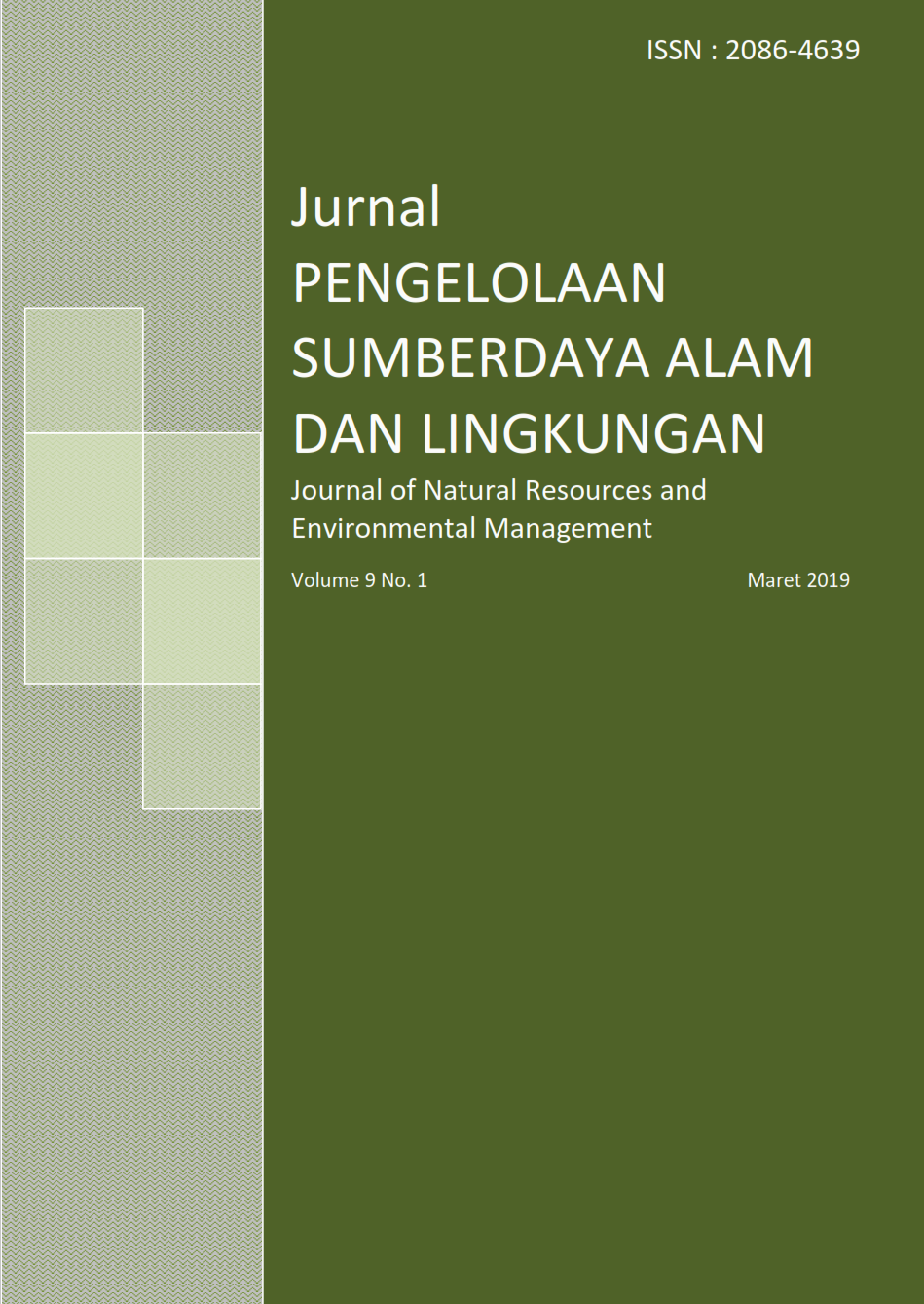HUBUNGAN SIFAT FISIK DAN KIMIA TANAH DENGAN PERTUMBUHAN MERANTI MERAH DI KHDTK HAURBENTES
Abstract
Failure in degraded forest rehabilitation was caused by using chosen species without pay attantion on site characterictics. Species selection by looking at site limiting factor, will increase success in degraded forest rehabilitation. This research aims to study the influence of physical and chemical soil properties on growth of Shorea leprosula Miq, Shorea palembanica Miq, dan Shorea mecisopteryx. Data was analyzed using multiple linear regression analysis with mean annual increment (MAI) of height and diameter as dependent variable and soil properties as independent variable. The results showed that growth increment of S.palembanica was the most species that influnced by soil perperties with R2 adjusted value for MAI-diameter and MAI-height repectively, 0.946 and 0.674 whereas others two Shorea have R2 adjusted value < 0.5. The research also showed that available P content was the limiting factor of the three species. There was a difference of each species in respond to the available P content. MAI-height on S. mecisopteryx and MAI-diameter and MAI-height on S. pelambanica will increase in line with decreasing available P content while S. leprosula required P available increasing in order to increase of MAI-diameter. This indicates that each species have specific response on certain soil properties content.
References
[KLHK] Kementerian Lingkungan Hidup dan Kehutanan, 2014. Statistik kementerian lingkungan hidup dan kehutanan 2014. Kementerian Lingkungan Hidup dan Kehutanan, Jakarta.
Apannah S, dan G. Weinland, 1996. Experience with planting Dipterocarps in Peninsular Malaysia. Dalam: Schulte A, Schone D, editor.Dipterocarp Forest Ecosystem: Towards Sustainable Management. Singapura, World Scientific Publishing.
Brearley, F.Q., 2012. Ectomychorrizal associations of the Dipterocarpaceae. Biotropica 0(0), pp. 1-12.
Hamzah, M. Z, A. Arifin, Zaidey, A.K, A.N. Azirim, I. Zahari, A.H. Hazandy, H. Affendy, M.E.Wasli, J. Shamshuddin, dan M.N. Muhamad, 2009. Characterctic soil nutrient statut and growth performance of palnted Dipterocarp and non-dipterocarp species on degraded forest land in Peninsular Malaysia. J. Applied Science, 9(24), pp. 4215-4223.
Karmilasanti, dan Maharani, R., 2016. Kenakeragaman jenis jamur ektomikoriza pada ekosistem hutan dipterokarpa di KHDTK Labanan, Berau, Kalimantan Timur. J Penelitian Ekosisitem Dipterokarpa, 2(2). pp. 57-66.
Kok Loong Yeong, G. Reynolds, dan J.K. Hill, 2016. Enrichment planting to improve habitat quality and conservation value of tropical rainforest fragments. Biodivers Conserv. 25, pp. 957-973.
Munawar, A., 2011. Kesuburan Tanah dan Nutrisi Tanaman. IPB Press, Bogor.
Nussbaum, R., dan A.L. Hoe, 1996. Rehabilitaion of degraded sites in logged-over forest using Dipterocarps. Dalam: Schulte A, Schone D, editor. Dipteroccarp Forest Ecosystem: Towards Sustainable Management. World Scientific Publishing, Singapore.
Otsamo, R.A. Otsamo, dan G. Adjers, 1996. Reforestration experiences with Dipterocarpa species on grassland. Dalam: Schulte A, Schone D, editor. Dipteroccarp Forest Ecosystem: Towards Sustainable Management. World Scientific Publishing, Singapore.
Pusat penelitian dan Pengembangan Hutan dan Konservasi Alam, 2005. Hutan Penelitian (HP) Haurbentes. Kehutanan Badan Penelitian dan Pengembangan Kehutanan Pusat penelitian dan Pengembangan Hutan dan Konservasi Alam, Bogor.
Riniarti, M., I. Mansur, A.S. Wulandari, dan C. Kusmana, Karakteristik akar berektomikoriza pada Shorea pinanga, Pinus merkusii dan Gnetum gnemon. J. Perennial. 6(1), pp. 11-19.
Schneider, T., M.S. Ashton, F. Montagnini, dan P.P. Milan, 2013. Groth performance of sixty tree species in smallholder reforestration trials on Leyte, Philippines. J. New Forest.
Soerianegara I., dan R.H.M.J Lemmens, 1994. Plant Resources of South-East Asia No. 5(1) Timber Trees: Major Commercial Timber. Pudoc Scientific Publishers, Wageningen.
Sovu, M. Tigabu, P. Savadogo, dan L. Oden Xayvongsa, 2010. Enrichment planting in a logged-over tropical mixed deciduous forest of Laos. Journal of Forestry Research. 21(3), pp. 273-280.
Subiakto, A., H.H. Rachmat dan C. Sakai, 2016. Choosing native tree species for establishing man-mad forest: anew perspective for sustainalbe forest managemnet in changing world. J. Biodiveristas. 17(2), pp. 620-625.
Tennakoon, M.M.D., I. A. U. N. Gunatilleke, K. M. Hafeel, G. Seneviratne, C.V.S. Gunatilleke, dan P.M.S. Ashton, 2005. Ectomycorrhizal colonization and seedling growth of Shorea (Dipterocarpaceae) species in simulated shade environments of a Sri Lankan rain forest. Forest Ecology and Management. 208, pp. 399–405.
Utomo, W. H., dan T. Islami, 1995. Hubungan Tanah, Air dan Tanaman. IKIP Semarang Press, Semarang.
Wahyudi, 2011. Pertumbuhan tanaman dan tegakan tinggal pada tebang pilih tanam indonesia intensif, stidu kasus di Areal Kerja IUPHHK-HA PT Gunung Meranti Provinsi Kalimantan Tengah. Disertasi. Sekolah Pascasarjana, Institut Pertanian Bogor, Bogor.
Wibowo, C., 2006. Hubungan antara keberadaan saninten (Castanopsis argentea Blume) dengan beberapaa sifat tanah: kasus di Taman Nasional Gunung Gede-Pangrango, Jawa Barat. Disertasi. Sekolah Pascasarjana, Institut Pertanian Bogor, Bogor.
Widiyatno, Soekotjo, M. Naiem, S. Purnomo, dan P.E. Setiyanto, 2014. Early performance of 23 dipterocarp species planted in logged-over rainforest. Journal of Tropical Forest Science. 26(2), pp. 259-26.
Authors
Authors who publish with this journal agree to the following terms:
- Authors retain copyright and grant the journal right of first publication with the work simultaneously licensed under a Creative Commons Attribution License that allows others to share the work with an acknowledgement of the work's authorship and initial publication in this journal.
- Authors are able to enter into separate, additional contractual arrangements for the non-exclusive distribution of the journal's published version of the work (e.g., post it to an institutional repository or publish it in a book), with an acknowledgement of its initial publication in this journal.
- Authors are permitted and encouraged to post their work online (e.g., in institutional repositories or on their website) prior to and during the submission process, as it can lead to productive exchanges, as well as earlier and greater citation of published work (See The Effect of Open Access).





